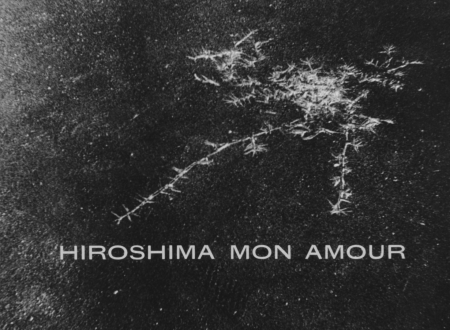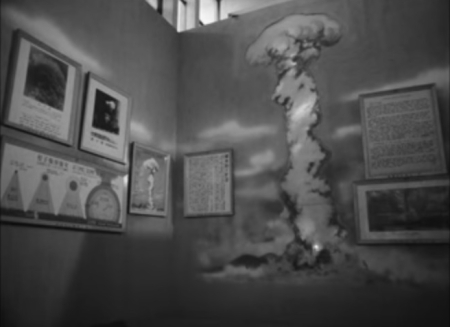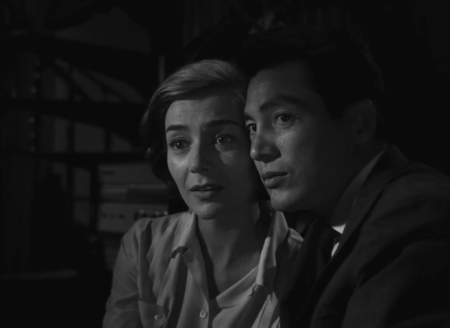
A French actress (Emmanuelle Riva) making a movie in Hiroshima meets a Japanese architect (Eiji Okada), and the two begin an affair. With both of them happily married to other people and the woman about to return to Paris, it seems destined to be short-lived, yet the man thinks they have something special. He wants to pursue a relationship; she refuses. Her reasons, as she gradually reveals, are tied to a past that haunts her and that, nevertheless, she dreads forgetting.
The 1959 film Hiroshima mon amour, directed by Alain Resnais and written by Marguerite Duras, was the title on my blind spot list that I most wanted to see, the French New Wave and Japan being two of my cinematic obsessions. High expectations are always dangerous, but this one did not disappoint. I was intrigued as soon as I saw the first image after the credits, though for a reason that Resnais could not have intended: a close-up of two sand-covered bodies embracing, it looks like a shot straight out of Woman in the Dunes, released five years later and, oddly enough, also starring Eiji Okada. Once I got past that initial surprise, I found myself transfixed by the film’s almost hypnotic opening sequence. Over a montage showing both modern-day (i.e., 1959) Hiroshima and the aftermath of the atomic bomb dropped there fourteen years earlier, and occasionally interspersed with shots of the couple, the woman muses on the city and the things she’s witnessed there; the man keeps replying, “You saw nothing in Hiroshima.”

Although I’m woefully ignorant of Resnais (must remedy that), I have seen his 1955 Holocaust documentary short Night and Fog. As in Night and Fog, the footage used in the opening of Hiroshima mon amour really brings the horrors of World War II to life — not easy to watch, but necessary. Fascinating, too, is the way the city has moved on, at least as best it can. Already, the bombing is a historical event, commemorated in a museum and recreated for the film that the woman has come to Hiroshima to make. I was particularly struck by a quick shot of a makeup artist putting the finishing touches on an actor playing a burn victim. It may be fakery for a good cause, as the film in question is a call for peace, but with countless people throughout Hiroshima still suffering the physical effects of the bombing (not to mention psychological damage), it comes across as rather tasteless, somehow.
At any rate, moving on after a tragedy is both necessary and inevitable, much to the woman’s dismay. Being in Hiroshima, the scene of such widespread tragedy, seems to reawaken her own painful, deeply personal memories of the war. For her, August 6, 1945, was a lovely summer day in Paris, yet she had just left behind her hometown — the significantly named Nevers, to which she never intends to return — and the war-related trauma she experienced there. As she admits to the man, she’s never even discussed her past with her husband. Maybe it’s easier with a stranger whom she’s not likely to see again; she can, in effect, leave it behind with him instead of having to live with it.

The thing is, she doesn’t want to forget what happened. Her goal is not (except subconsciously, perhaps) to unburden herself and then carry on with her life. Forgetting would mean losing her first love, a man killed at the end of the war, and she already feels that she’s betrayed him by recovering from the temporary madness that his death brought on, by continuing to live and love again. When she reveals her story to the Japanese man, she addresses him as if he’s this long-lost lover, thereby keeping the dead man alive a little longer. The new affair, too, is something that she’s afraid of forgetting, yet she also believes that if she were to stay with this man in Hiroshima, they would eventually forget what had brought them together — another terrifying failure of memory.
There’s so much going on in Hiroshima mon amour that it’s impossible to absorb it all in one viewing: questions of personal, national and universal experience, of war, of time, of memory, of death, of human nature. Then there’s the dialogue, poetic and mesmerizing through its repetitiveness, and the gorgeous black and white cinematography. I saw many things in Hiroshima, and I’m eager to watch it again; I suspect it’s one of those films that only becomes richer with repeated viewings.
This post is part of the 2016 Blind Spot Series, hosted by The Matinee. My full list can be found here.


Love your post…much more than I loved this film, I’m afraid. I felt it indulgent and trivial compared to the backdrop of the nuclear holocaust. But it is beautifully shot, and well crafted. I can see why people love this film, but I can’t join them.
LikeLiked by 1 person
Thanks! I can see that, but I didn’t see her story as the equivalent of the bombing. It’s difficult to put into words, but I think that Hiroshima was something immense and incomprehensible to her, and yet people were going on with their lives… I’ll need to watch it again to get my thoughts in order, but my interpretation was something along those lines.
LikeLike
I find it hard to put into words exactly why I didn’t like it, so…😀
LikeLiked by 1 person
Fair enough. 🙂
LikeLiked by 1 person
Thank you for your post, Erin! My taste in films run from the silent era to pre-code to gangster to film noir, for the most part. I haven’t seen as many French new wave films as I’d like (“Alphaville”, “Rififi” and a few others), and this film was also on my list to see “some day”. Your post inspired me to rent it today, and after watching it, I feel as if I’m in a daze. What a powerful film. It was a very visceral experience for me—it covered so much in 90 minutes. If I can put my thoughts into words, I’ll write more. But thank you for writing about “Hiroshima Mon Amour”, and now I’d like to see more Resnais.
LikeLiked by 1 person
Thank you, and I’m glad you enjoyed it! (Although maybe “enjoyed” isn’t quite the right word.) It really is a lot to take in, isn’t it? I had a hard time putting my thoughts into words, too, so I’d like to write more about it after I watch it a second time, whenever that may be. Like I said, I’ve seen very little Resnais — just this, Night and Fog, and a short documentary about plastic called Le chant du Styrène — but Last Year at Marienbad seems to be his other must-see film.
LikeLike
Erin, I was astonished to see this included in your Blind Spot Series. (I haven’t seen it, but that’s not surprising coming from me.) So I was intrigued to read your review, coming from a first time viewer. A lot of people fall in love with this film, and it appears you were captivated as well.
LikeLiked by 1 person
Thanks! Yes, it’s one that I really should have seen ages ago but didn’t somehow — my library doesn’t have it, and it’s not on Hulu or Netflix, so I had to wait for it to turn up on TCM. I’m glad that I finally got around to it.
LikeLiked by 1 person
Pingback: Blindsided by L’AVVENTURA | The Matinee | Cinematic Passion & Perspective